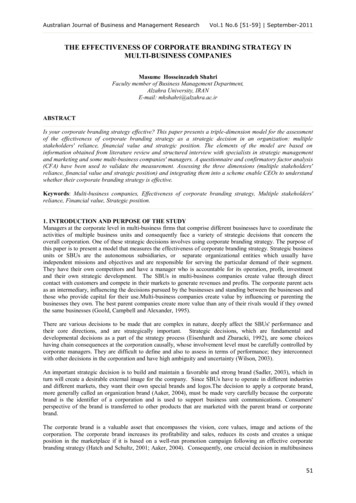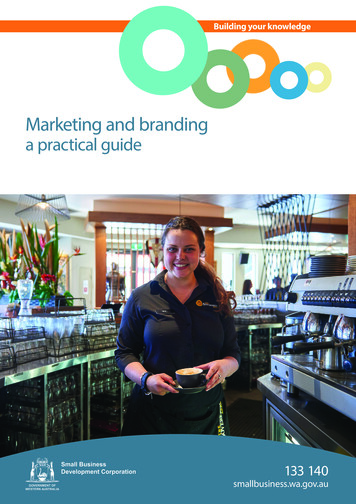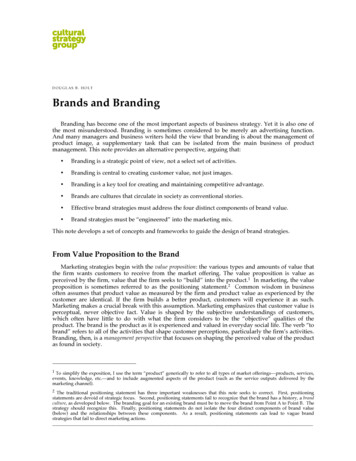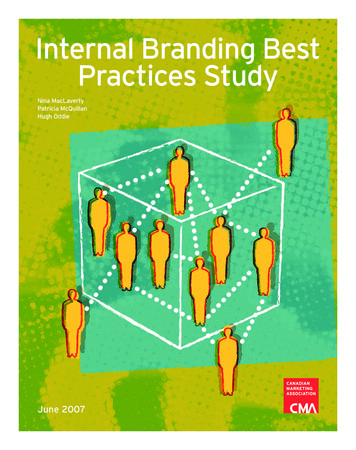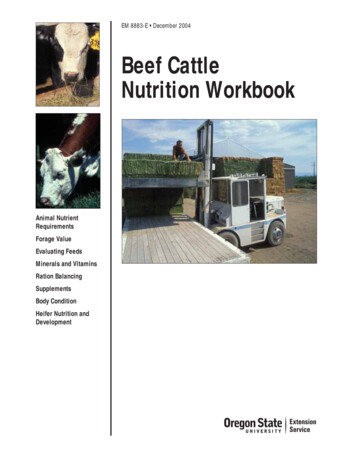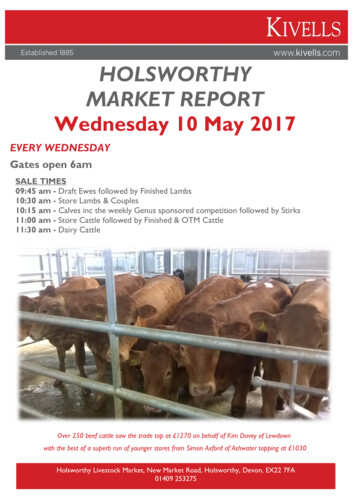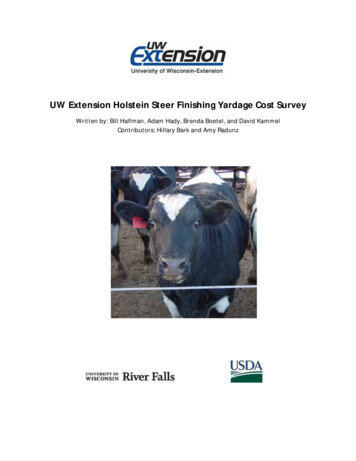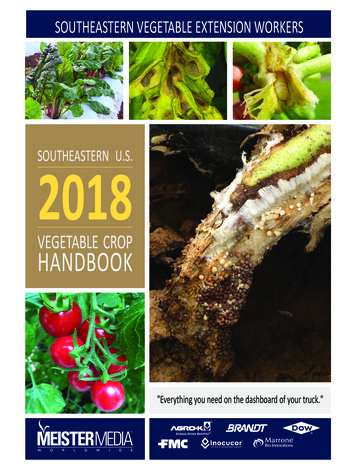
Transcription
Branding CattleGrade Level:4Duration:1 hourDescription:Subjects:Social Studies, Information LiteracyThe purpose of this lesson is to make students aware of why cowboys use brands andhow brands are designed and read.PASS—Oklahoma Priority Academic Student SkillsSocial Studies 1.1Demonstrate the ability to utilize research materials, such asencyclopedias, almanacs, atlases, newspapers, photographs, visual images,and computer-based technologies.Social Studies 5.1Identify major historical individuals, entrepreneurs and groups, anddescribe their major contributions.Social Studies 5.2Describe major events of Oklahoma’s past, such as settlements by NativeAmericans, cattle drives, land runs, statehood, and the discovery of oil.Information Literacy 3.3 Know how to use information to communicate ideas andtake appropriate action.Goals: Students will learn why brands were important during the cattle drives through Oklahoma inthe late 1800s and why we still use them today.Students will learn how brands are designed and read.Objectives: Students will design their own brand and answer questions related to branding.Assessment:Students will design an original brand and describe how to read it. Students willanswer worksheet questions about branding.Primary Source Materials: Photographs, historic and current, of cowboys branding cattle. Oklahoma Brand Book, published by the Brand Division of the Oklahoma Cattlemen’sAssociation.Additional Resources: The Cowboy at Work: All About His Job and How He Does It by F. E. Ward (New York: HastingsHouse, 1958). The Cowboy's Own Brand Book by Duncan Emrich (New York: Dover Publishers, 1995). The Manual of Brands and Marks by Manfred R. Wolfenstine (Norman: University of OklahomaPress, 1970). For information about registering a brand in Oklahoma, see Oklahoma Cattlemen’sAssociation site at www.okcattlemen.org/. “The History of Cattle Brands” at www.barbwiremuseum.com/cattlebrandhistory.htm Lesson Plans at Oklahoma Ag in the Classroom site at www.clover.okstate.edu/fourh/aitc/ and“A Look at Oklahoma Agriculture” found at www.agclassroom.org/kids/stats/oklahoma.pdf.
Vocabulary:BrandMavericksRustlerA permanent identification mark usually burned into the hide of an animalwhich is used to show ownership.Unbranded animals. Their ownership may be questioned when they are foundseparated from the herd.Someone who steals cattle or other livestock. Rustlers may brand unmarkedcattle with their own brand or alter any existing brand.Procedure:Ask students to describe how people use or benefit from cattle. Besides food products, many items weuse everyday are made with inedible beef by-products. Examples include: Food Products: Beef, dairy products such as milk, cheese, and yogurt. Beef is consumed 77million times daily across the United States. According to a recent research survey, more than8.2 billion hamburgers and cheeseburgers were served in restaurants in 2001.Household Items: (From fats and fatty acids) Candles, perfumes, soaps, cosmetics, car polishesand waxes, paint brushes, and photographic film.Leather: Used in boots, shoes, luggage, footballs, furniture and car upholstery.Medicine: More than 100 medicines used by humans come from cattle.Fertilizer: Manure is the most widely used fertilizer in the world.Have students review photographs of cowboys branding cattle. Ask students to talk about what theysee. Suggest they describe the sights, sounds and smells they might experience if they were at thescene. Have students consider what each participant might be thinking or feeling.History of Branding A brand is a mark burned into an animal’s skin. Owners use brands, which never wear off, toidentify their animals. The practice of branding is ancient. Some Egyptian tomb paintings atleast 4,000 years old show scenes of roundups and cattle branding. Burning an identifying mark into the hide of an animal was the only method of marking thatlasted the life of the animal, until the invention of the tattoo. The practice of branding came tothe New World with the Spaniards, who brought the first cattle to New Spain (Mexico). Cattle are usually branded when they are calves. Brands are usually placed on thehindquarters, hip, shoulder or side. In Oklahoma, brands must be at least 3 inches in lengthand width. Smaller brands may be difficult to read from a distance. Branding is done during spring and fall roundups. On the open range, cattle from differentranches often grazed together. During the roundups, cowboys from the different rancheswould work together to drive cattle to a central location for branding. Older cows werealready marked. Calves followed their mothers and were marked with the mother’s brand. It takes several cowboys working together to brand each calf. Branding irons, which are longmetal rods with identification figures on the end, are heated in a fire and then used to burnthrough hair to permanently mark the hide of the animal. When cattle are branded today,vaccinations are given at the same time to prevent certain diseases. Brand registration did not begin until the 1870s or 1880s. During this time, millions of cattlewere moved on cattle drives from Texas through Oklahoma to Kansas to be shipped by rail toprovide food for those living in the Eastern part of the United States. Cattle were driven toKansas because railroads did not come through Texas or Oklahoma at that time. The land was not fenced, so it was not uncommon for cattle to wander away from the herdand become lost. Also, cattle might be stolen by rustlers. The brand would indicate theidentity of the owner. Unmarked cattle are often called mavericks, after Sam Maverick, a Texas lawyer and politician.At one time, Mr. Maverick received cattle instead of cash to settle a fee for legal services.Although he hired a cowboy to brand his cattle, many of them were never marked. Over time,many of his cattle were stolen and marked with different owner’s brands.
In Oklahoma today, brands are registered with the Oklahoma Cattlemen’s Association. TheAssociation publishes the Oklahoma Brand Book, which includes more than 10,000 brands.Brand books list all registered brands and include the drawing of the brand, owner's name,year brand was registered, ranch and city.Brand designs include combinations of letters, numerals, and other symbols, such as circles orboxes. Simple drawings of common subjects such as a heart or diamond are often used.Because of the numerous brands already registered, new brands often contain 3 characters.Discuss how to read brands. (See the “How to Read and Design a Brand” worksheet). The ability toread a brand is known as “calling the brand.” Discuss other ways of marking animals to showownership, such as ear tags, tattoos, electric brands, nose rings, ear notches, etc. Often ranchers usemore than one method on each animal.Consider how brands are similar to and different from the following: license plates on cars,identification tags on pets, hospital identification bracelets on patients, employee identificationbadges, name labels on books or school supplies, designer or sports team logos on clothing.Ask students how they could learn more about branding and the cattle industry in Oklahoma today.Suggestions for primary sources could include interviews with local ranchers; visits to museums withcollections related to the cowboy, cattle or Oklahoma history; or statistics from government sourcesabout the cattle industry in Oklahoma. The United States Department of Agriculture estimates thatthere are more than 95 million cattle in the U. S. today, with 5 million located in Oklahoma.Have students create a brand and describe it using the “How to Design and Read a Brand” worksheet.Have students present their brands and explain their design to the class. Display the different brandsin the classroom. Have students complete the “Branding Cattle” worksheet.Additional Suggestions: Create a class brand book of the brands designed by the students. Have students discuss theschool brands and vote on the brand they think most represents their school. Have students review the Application for Registration of Brand and Marks. Find the form atwww.okcattlemen.org/images/Brand app.pdf. [Note: The two dots before "pdf" are unusual and intentional.] Invite a local rancher to visit the class to discuss the branding process and how cattle areidentified on ranches today or take a field trip to a local ranch. Take a field trip the National Cowboy and Western Heritage Museum in Oklahoma City.Contact them at (405) 478-2250 or www.nationalcowboymuseum.org/m tour el.html. TheMuseum also has a traveling trunk of cowboy items. Contact Sue McCoy at 405-478-2250, Ext.264 or smccoy@nationalcowboymuseum.org. Invite a member of the Education Staff of the Oklahoma Historical Society to visit the class.Contact Mike Adkins at (405) 522-5248 or madkins@ok-history.mus.ok.us to schedule a visit.OHS also offers a traveling trunk containing cowboy equipment that can be loaned to schools. The Diamond R Ranch website, sponsored by the National Cowboy & Western HeritageMuseum, includes numerous cowboy activities for students such as games, songs, tours,exhibits at www.nationalcowboymuseum.org/diamondr/index.html. Take a field trip to a local museum or historical society, such as the Chisholm Trail HistoricalMuseum in Waurika, the Chisholm Trail Heritage Center in Duncan, or the Chisholm TrailMuseum in Kingfisher. If a visit is not possible, ask a staff member to visit the classroom topresent information and encourage students to visit the museum or historical society. Formore information about museums and historical sites, see the Oklahoma Tourism andRecreations Department’s “What To Do” section of its website at www.travelok.com/.
Read brands from left to right, top to bottom, and outside to inside. Symbols, numbers and capital letters can be used. Letters and numbers are read as letters andnumbers. A brand that looks like “51A” would be read “fifty-one A.” Simple outlines of familiar objects, such as a quarter moon, sun, diamond, triangle, or heart, canbe used. Often these relate to an owner’s name or interests. “-” is read as bar; “ ” is read as rail; “/” is read as slash. The position of the letters determines how the brand is read. For example: Tumbling Crazy Reverse Running Lazy RockingLetter is turned partially on its face or back.Letter is upside down.Letter is backwards.Letter is cursive.Letter is on its side in a horizontal position.Letter is placed so the lowest part touches the inside of a curve. Dashes can be added at the tops or bottoms of the letters to indicate wings or feet. Flying Dashes are placed at the top of the left and right of the letter. Walking Dashes are placed at the bottom of the letter.Use the guidelines above to design your own brand and a brand for your school. As you design yourbrand, think about your own interests and activities.Please write the names of your brands and explain what they mean.
Answer the following questions about branding cattle.1. Unmarked cattle are often called2. Identify four products we get from cattle:3. Why do cowboys brand cattle?4. Why were cattle driven from Texas to Kansas in the late 1800s?5. Someone who steals cattle or other livestock is a6. Write the names of the following brands?7. Where are brands usually placed on cattle?
identify their animals. The practice of branding is ancient. Some Egyptian tomb paintings at least 4,000 years old show scenes of roundups and cattle branding. Burning an identifying mark into the hide of an animal was the only method of marking that lasted the life of the animal, until the invention of the tattoo. The practice of branding .


